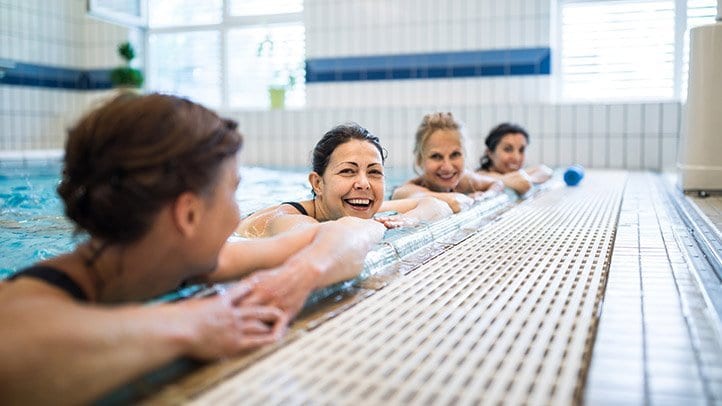A cheat sheet on age-related exercise recommendations for perimenopause and menopause.
Are you an avid gym-goer, do you prefer to work out at home, or honestly, have you not even had a sweat session in quite some time?
Regardless of one’s fitness level, exercise for women in their forties and beyond is somewhat different than for those in their twenties and thirties. Physical changes, such as slower metabolisms, hormonal changes during perimenopause and menopause, and the higher risk of developing cardiac and bone issues in this time of life all make it important to take a closer look at best practices for fitness in your forties and fifties.
Midlife Is the Time to Move, Strengthen Muscles, and Stretch More
Both the World Health Organization and the Centers for Disease Control and Prevention (CDC) recommend at least 150 to 300 minutes of moderate exercise or 75 to 150 minutes of vigorous aerobic exercise a week for adults up to age 64. (1,2) That works out to about 30 minutes a day, five to seven days a week. It’s also recommended that adults do muscle-strengthening exercises, focusing on all areas of the body, at least two days a week. And in midlife, it’s important to incorporate stretching both before and after physical activity, to better prepare the body for a strong workout.
Here are four tips on how to exercise smarter in midlife:
1. Amp Up Aerobic Exercise to Help Reverse Increased Risk of Heart Disease
As you get older, your risk of having heart disease increases, according to the American Heart Association. (3) While men are more likely to have a heart attack than women, it’s important to stay as heart-healthy as possible. One way to do that is to keep doing or build up to doing those recommended amounts of aerobic exercise each week; this activity helps build the heart muscle by getting it to pump faster. In a study published in January 2018 in Circulation, the journal of the American Heart Association, researchers found that a group of adults in their fifties who exercised for about 30 minutes on most days for two years were found to improve their fitness levels (they were previously sedentary or exercised just a little) and helped reduce heart stiffness, which improved heart health. (4)
The takeaway: Start or continue to do 30 minutes of aerobic exercise, such as brisk walking, running, biking, or dancing. Then build up weekly workouts to the levels of study participants. Their routines included:
Participants built up to those activity levels, beginning with three 30-minute moderate exercise sessions for the first three months, after which high intensity exercise was included. (5)
2. Build Your Bones With Strength Training
Especially after ages 40 to 50, your risk of breaking a bone increases, as bones are as strong as they’ll ever be. Women, who typically have thinner bones than men, are more likely to deal with osteoporosis, which is weakened bone or bone loss, and is more likely as estrogen levels drop at menopause.
Certain exercises go a long way to help strengthen muscles, which can help prevent falls, and therefore, breaking a bone. They also help maintain better posture, strength, flexibility and movement, according to the National Osteoporosis Foundation. (6) These moves should be done along with strength training, which uses weights to help build muscles, along with aerobic exercise.
The takeaway: One such move is the toe-heel raise, which makes the lower legs strong and improve balance:
Toe Raises and Heel Raises
3. Move More for Mental Health and Mood Benefits
A study published in December 2018 in the journal International Psychogeriatrician found that many adults claim they are lonely, with loneliness peaking among adults in their late fifties. (8) Such loneliness is linked with worse mental health, such as feeling depressed or anxious. But previous research published in Primary Care Companion to The Journal of Clinical Psychiatry showed that aerobic exercise has could improve anxiety and depression due to increased blood flow and the creation of endorphins, brain chemicals that are related to happiness. (9)
The takeaway: First, don’t hesitate to talk to your doctor if you think you are experiencing symptoms of depression. If you aren’t regularly clocking 30 minutes of cardiovascular exercise on most days, experiment with moving more. Try jogging, swimming, cycling, walking, gardening, or dancing for at least 10 minutes and see if your mood improves. Aim to build up to 30 or more minutes a day if you can.
4. Incorporate Interval Training Into Workouts to Help Ease Menopausal Symptoms
The years leading up to menopause, known as perimenopause, are characterized by hormonal changes that can cause hot flashes, sleeplessness, and irregular periods. While exercise doesn’t prevent these unpleasant symptoms, cardio exercise can help reduce weight or maintain a healthier weight (leading to lowered risks of developing certain cancers, heart disease and type 2 diabetes, according to the Mayo Clinic) as well as lower stress levels. (10) Menopause is also a time when the body retains more fat in the abdominal area, leading to what some call the “menopot” or potbelly. Regular intense exercise can help keep belly fat at bay.
The takeaway: The North American Menopause Society (NAMS) recommends interval training, which incorporates exercise at a healthy rate, then increasing intensity for a short sprint, then repeating. (11) One example is walking for five minutes, then jogging for one minute, then walking again, repeating the minute of jogging for several intervals. Research published in The Journal of Mid-life Health also cited the importance of exercise during and beyond menopause to maintain optimal health during this period. (12)
This content was originally published here.







